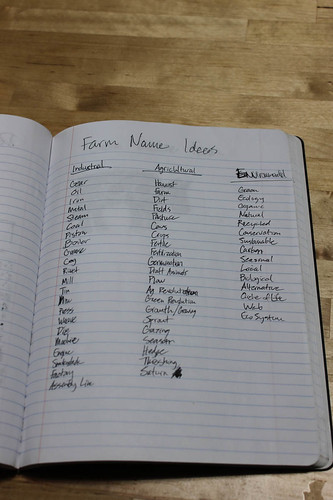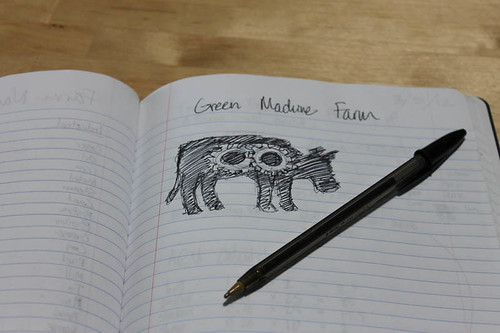Ok, quick! Think of the last thing you bought from someone’s farm.
What did their logo look like? What color(s) was it? What did their text look like?
If they’re like most small farmers, you probably can’t remember. Maybe they didn’t have a logo at all, and maybe it was just pretty “blah” to look at so you forgot all about it.
You want your logo and farm name,which should be part of your logo, on everything. Your logo is the way to get your farm name out there, to get your customers to associate your product (a tangible thing) with your farm (an intangible entity). This is what they call “branding.” Your brand is the idea that is in your customers head, about what your farm and your products are about. This idea all starts with your farm name.
Farm names come in roughly 4 different categories (at least according to me).
- Geographical – describing a place or landmarke.g. Windy Hill Farm
- Personal – describing a person, usually the proprietore.g. Smith Farm
- Conceptual – describing an idea e.g. Pastoral Fantasyland Acres
- Hybrid – a mix of any of the above
So which one of these types of names are best? There is no best, but there sure might be one that suits you a lot better then the others. I have a general rule of thumb that says to look at what the majority of people around you are doing, and don’t do what they do. For farmers, this means usually staying away from geographical names unless you have a darn good reason for doing so. If I had a dime for every geographical farm name, I could afford a pretty nice farm of my own. If you’re trying to come up with a name only use a geographic name if you have a place or landmark that is truly historic or meaningful.
So how about personal names? Personal names are great, unless you have a funky name that a majority of people are going to have a hard time with. Even so, feel free to have a little fun with names. Nicknames, ironies and oxymorons are all fair game.
Conceptual names can be the best of all (in my opinion) when done correctly. Conceptual names need to convey an idea that is central to your philosophy/story. To do it right, you’ll have to distill your entire philosophy down into a very few words. Shoehorning a big idea down into a few measly words is tough, but totally worth it.
Hybrid names? Well, it’s anything that doesn’t fit comfortably into the other three.
So, if you already have a farm name then you’re in good shape. Stick with the name you’ve got. There’s no use changing horses mid-stream.
If you’re trying to come up with a name, start by listing a few ideas, themes, or categories that you’d like to have in the name. For example, I used “Agriculture” “Environmental” “Industrial”

Then as fast as you can, write down every word you can possibly think of within those categories. Don’t censor yourself during this process, write it down even if it sounds stupid, try to get down as many words as possible.
It also helps to write down as many different words for “Farm” as you can think of. (Ranch, Gardens, Acres, Pastures, etc.)
Once you’ve got your lists of words, look through them and start coming up with some combinations that you like. That should at least give you a starting point for coming up with a name.
Now if you have any artistic leanings whatsoever (stick-figures totally count) start doodling based off the same word list, and see if you can’t find a few images that work together. If you don’t have any artistic skills, go to our good friend google and start looking for pictures that you like related to those words.
Here’s my first sketch of what would become my logo. For someone who’s been around cattle for half his life, I sure can’t draw them very convincingly.

Now we have a name and ideas for a logo, it’s time for the last piece of the puzzle, a typeface.
Typefaces or Fonts are an often overlooked and abused tool for conveying meaning. A well-chosen font can help reinforce the message that your name and logo are sending. Start hitting all the free-font internet sites and browse to your hearts content. Make sure that you’re picking a font that compliments the “feel” that you’re going for (e.g. clean & modern, old-timey, rustic, earthy, etc.) Jot down the names of any fonts you like, and download them on your computer.
Using your new fonts, type out your farm name in a word-editing program and see which ones you like. Remember your Shakespeare: Discretion is the better part of valor. Use the most subtle font that still conveys that feel that you’re going for. You’re trying to convey your message, not beat people over the head with it.
At top are the two fonts I ended up using: BorisBlackBloxx and Avenir.

Ok, one more choice to go. Color(s). For reasons that will be explained later, it is usually cheapest to stick with a 1-color logo. To make it cheaper still, stick to a common PMS color. What’s a PMS color? Well, it’s not that important right now, it’s a printing thing. But if any of those common colors look good to you, pick it and stick to it. You’ll thank me later.
Here is my color: PMS 3425 – Kelly Green.

Anyway, it’s at this point that for-real, professional software is needed. We’re talking about the good stuff, Illustrator, Photoshop and InDesign. If you have these programs and know how to use them, then get to work!
If you don’t have the programs, or the know-how to use them, don’t worry. There are people around you who do. Pay them to do the work, it’s worth it. Look around for a commercial printer, screen-print shop, or a sign & banner place. They’ll usually have a small staff of designers who can design you something for $60-120.
Take in your sketches or pictures from Google, your farm name, any fonts you have chosen, your color preferences and let them do their work.

[…] that we’ve got part 1 out of the way, and we’ve already established our farm’s identity or […]
[…] we’ve already covered the basics of farm marketing. We’ve come up with our farm’s identity, and we’ve put that identity (brand) to use. Now comes the part where we actually come up […]